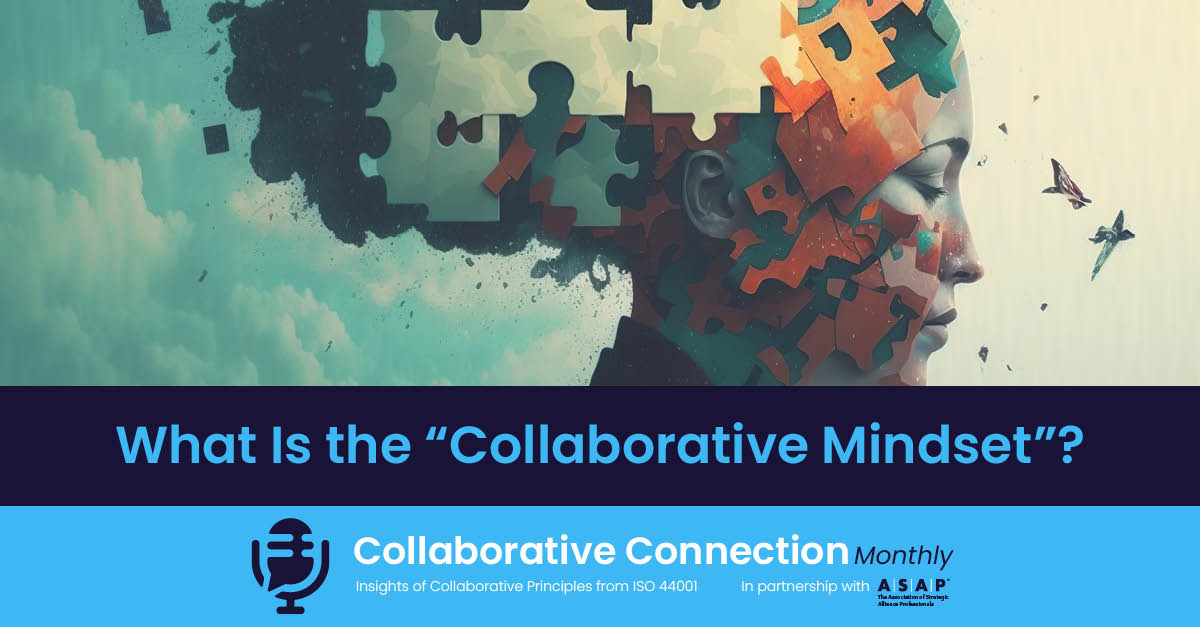What Is the “Collaborative Mindset”?
This month’s Collaborative Connection Monthly saw the return of an old “friend to the program,” as they say in the business. ASAP’s original founder Robert Porter Lynch, CA-AM, president of The Warren Company, joined moderator Greg Burge, CSAP, principal of Collaborative Partnering Services, from his living room, which was adorned with the chair George Washington sat in when planning his Revolutionary War strategy, and, according to Porter Lynch at least, the rifle the first US president used to help execute it.
As to the aim of ASAP’s first president, we cannot tell a lie: it was to answer the question posed in the title of his presentation, “Do You Have What It Takes? Developing a Collaborative Advantage Mindset.” Porter Lynch laid the groundwork for this discussion by discussing the relatively recent history of technological innovation.
“Every time a new technology has shown up in the last 200 years, it has created a new set of ecosystems, and those have all morphed into what we call value networks,” he said.
He cited several examples, including:
- The railroads and shipping networks spawned by the steam engine,
- Telephones produced after the introduction of the electric grid,
- The highways necessary to facilitate rapid movement enabled by gasoline-powered vehicles,
- Radio and television networks of the electronics age, and of course,
- Today’s digital age, which has spanned PCs, the Internet, and now AI.
To the Collaborator Go the Spoils
Individuals and companies won’t be able to navigate these networks without mastering the collaborative mindset, but those who do will enjoy the spoils. According to Porter Lynch’s figures and past observations, effective collaboration reduces risk in large, complex projects by 30 percent and triples the likelihood of these initiatives coming in on time and on budget. Advantage: alliance professionals.
“There’s a massive competitive advantage that you get with your collaborative advantage,” said Porter Lynch.
Healthy Skeptics Can Be Worthy Adversaries
One of the first steps toward designing what Porter Lynch called a “solution set” or “design architecture” for the collaborative mindset is to identify three patterns of human behavior: 1) adversarial, 2) transactional (i.e., everything is viewed as a deal), and 3) collaborative (i.e., creating that 1 + 1 = 3 spirit). Although the latter is the ideal in a business relationship, Porter Lynch did stress that the first two approaches are appropriate to certain situations.
“There are times we have to be adversarial, there are times when just a deal is perfectly fine,” he said. However, those that fall primarily into these categories are often an impediment to collaborative behavior and alliance success. “Those that are adversarial really may be stuck [in their ways],” said Porter Lynch, especially if they are the type who believe “it’s a dog-eat-dog world.”
ASAP’s founder did urge people not to confuse adversarial colleagues with “healthy skeptics.”
“Those are the fun ones to work with,” he said, but not if they take it to an extreme. “You can never change a cynic. It’s a lost cause.”
Be a Champion of Trust and Integration or “Get Out of My Office”
Porter Lynch noted three broad elements to this collaborative mindset:
- Trust – Porter Lynch gave the audience a quick glimpse of his poster depicting the “Ladder of Trust” and the “Tornado of Distrust,” which are separated by a belt with the former on top and the latter below. Porter Lynch spoke of a past C-suite client of his telling employees who fell below the belt to “either change your perspective or get out of my office.” Porter Lynch noted that trust also encompasses fairness, accountability, respect, truthfulness, ethics, safety, and transparency, among other elements.
- The power of integration – “It allows you to work across the boundaries of organizations, to be cross-functional in organizations, to fix the silo problems when everybody is in their own little castle,” said Porter Lynch, before adding that where good integration used to translate into 15 percent better competitive advantage, McKinsey now pegs that number in the 30 to 40 percent range.
- A collaborative champion – These leaders use “action learning” in workshops to get their charges to “apply, apply, apply” their collaborative principles; Porter Lynch asserted that participants retain 80 percent of the knowledge they learn if they apply it quickly. Otherwise, they lose that information in three weeks.
“The greatest collaborative champions and leaders are also great teachers,” he added.
You Can’t Refuse These Tips from ASAP’s “Godfather”
Asked how to inculcate the collaborative mindset in organizations, Porter Lynch threw four more guiding principles at the audience.
- Build a critical mass inside your organization of others who are collaborative – In this regard, Porter Lynch stressed the importance of having a “Godfather.” “This is someone who is more than an executive sponsor, it’s someone who will stand up for you if you come under attack.”
- Create a rigor and discipline – Instill the collaborative mindset throughout the alliance and project teams.
- Build capabilities – Use an “action learning program,” in which teams implement an idea to solve a problem and capture an opportunity.
- Measure and reward collaboration – Use hard metrics and tie collaboration practices to positive company results. “Otherwise, the system will unfold on you very fast,” said Porter Lynch.

